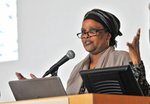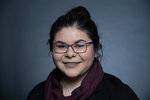

Refugee and immigrant children in the U.S. often face trauma and systemic barriers including a lack of linguistically and culturally appropriate services, affordability, and stigma. These compounding factors decrease the likelihood of seeking services. The CIRCLE Project aims to change that by providing support to East African and Latinx children and their families.
To learn more about the CIRCLE Project, we spoke to Dr. Saida Abdi, PhD, MSW, LICSW, Assistant Professor at the University of Minnesota School of Social Work.
Dr. Saida Adbi, originally from Somalia and a refugee, is the CIRCLE project director. She has worked for many years developing interventions for refugee/immigrant children across the world.
This interview has been edited for clarity and length.
Q: What is the CIRCLE Project?
SA: The CIRCLE (Collaborative for Immigrant & Refugee Children Leadership & Excellence) Project is based on an intervention we developed at Boston’s Children’s Hospital (BCH). We were looking at what refugee and immigrant children need. If you are coming through our borders, we know you are experiencing trauma. This means, given their experiences, immigrants need support, safety, language, and cultural access.
So we asked the [immigrant] communities, if your child needed help – where would you go? The only outside system that they identified was schools because, as they said, “I’m already sending my kids there.” So, we have to be in a school.
The CIRCLE Project uses a tiered model. Tier 1 is community engagement. We focus on community outreach – a Cultural Broker might be out in the community talking to families. Tier 2 is group work [in schools]. We bring groups of children together and we do fun activities. A Cultural Broker joins those groups. Groups give kids access to support fast so many kids don’t need to come back for one-to-one therapy because they have connected in the groups. And we’re seeing evidence that the groups are helpful. Tier 3 is traditional, clinical services. Children can receive individual therapy with [school-based] clinicians. Tier 4 is acculturation and home-based services. A Cultural Broker and clinician work together and go into homes.
Q: What is a Cultural Broker?
SA: We realized you cannot do this work if you do not have a cultural bridge to the communities we’re working with. The Cultural Broker is a bridge between service systems and communities. The Cultural Broker is someone who not only translates what the patient said but provides context. Specifically around mental health, we want clinicians to have a bigger contextual understanding of not only what the mental health symptoms are, but also how people make meaning of those symptoms. Whenever we train Cultural Brokers and clinicians, we say “Come as a learner before you become a helper.” Their job is to expand how we think about services and to provide the lens of the community into the services we’re providing.
Q: Why Minneapolis?
SA: We came to Minneapolis for this reason: the large number of Somali and East African immigrant and refugee kids here. The model is built on this idea of not coming into communities and making them do things. It’s building on what already exists. It was important for us to partner with community agencies that are already embedded in those communities. And we already had some relationships with Minneapolis agencies.
Q: Who are the partners in the project?
SA: BCH is a model development site, so they do the training for us in our project. Through the BCH work, Watercourse Counseling Center and I had a long-existing relationship. We were fortunate to find CLUES (Comunidades Latinas Unidas En Servicio) as a partner and also SAPA (Somali American Parent Association). SAPA does a lot of outreach, Cultural Brokering, and work with Somali and East African families and parents, and have been in the schools for years. And CLUES – one of the biggest mental health providers in the Twin Cities to Latinx, families, and communities – contributed a Cultural Broker to the project.
This model is an intentional partnership with the community. We’re building capacity, ensuring that if we leave - it’s going to stay with the communities. It’s such a great opportunity because we also have a partnership with Minneapolis Public Schools (MPS) and the University of Minnesota.
Q: How will this project engage families living in the community?
SA: This project’s motto is that you cannot just teach a child. It’s fundamental that we train the parents and the schools so that everyone who is in the child’s social environment can support the child.
We found that if the family is struggling, then we engage the whole community in services to help the child. We teach them how to communicate across cultures. We work in the community with families and in systems. Social ecology doesn’t demand a child to do better. It asks everyone around the child to be better and, if you do, then the child will do better.
Q: What do you need for this to be successful?
SA: The grant is community-based. It’s by bringing clinicians and Cultural Brokers together that we do a good job of taking care of families and children. I need the grace of being supported by each other, working together – never taking our eyes off the goal of taking care of kids and families.
And finally, that we all become ambassadors and champions of children and families. This is not a one-person, one-company, one-organization job. It has to be done in partnership with families, communities, schools, and providers. We are here to support and partner with you, to work with you, and to do whatever is needed to get this done.
The CIRCLE Project is a community-based program that is intentionally partnering with local organizations and schools in our community.
A special thank you to Dr. Saida Abdi for answering our questions, for being a systems change-maker and for continuing to advocate for community, family, and individual resiliency for refugee and immigrant communities.
Comments
No comments on this item Please log in to comment by clicking here